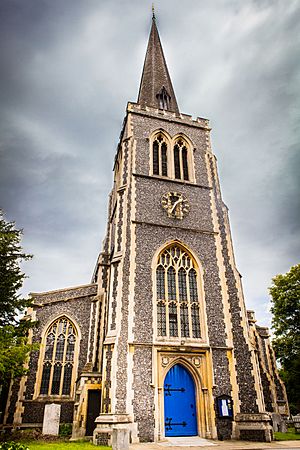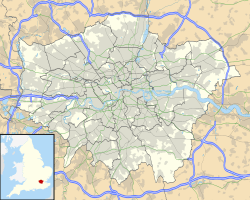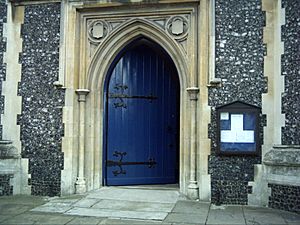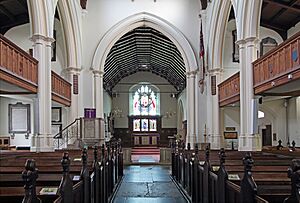St Mary's Church, Wimbledon facts for kids
Quick facts for kids St Mary's Church, Wimbledon |
|
|---|---|

St Mary's Church
|
|
| 51°25′43″N 0°12′38″W / 51.42849°N 0.21060°W | |
| OS grid reference | TQ 24502 71458 |
| Location | Wimbledon, London |
| Country | England |
| Denomination | Church of England |
| History | |
| Founded | before 1086 |
| Architecture | |
| Heritage designation | Grade II* |
| Architect(s) | Sir George Gilbert Scott |
| Style | Gothic Architecture |
| Years built | 1843 |
| Administration | |
| Parish | Parish of Wimbledon |
| Deanery | Merton |
| Archdeaconry | Archdeaconry of Lambeth |
| Diocese | Diocese of Southwark |
St Mary's Church, Wimbledon, is a historic Church of England church in south-west London. People have worshipped on this site for over 900 years. The first church here may have been the one mentioned in the famous Domesday Book of 1086.
Today, the church is still very active. Because of its long history and beautiful building, it is protected as a grade II* listed building. This means it is a very important building for the nation's history.
Contents
The History of St Mary's
There have been four different church buildings on this spot over the centuries. Each one was built to replace the one before it.
- The Medieval Church was the first one, standing from the 11th to the 13th century.
- The Second Church was built in the late 13th century and lasted until 1786.
- The Georgian Church was a more modern style for its time, used from the 1780s to the 1840s.
- The Victorian Church is the building you can see today. It was finished in 1843.
Today's Victorian Church
The church we see now was designed by a famous architect named Sir George Gilbert Scott. He was given a very strict budget of £4000, which was a lot of money back then. To save money, he cleverly used parts of the older Georgian church in his new design.
If you visit, you can still spot some of these older sections. One of the most impressive new parts he added was the tall tower and spire, which reaches a height of 196 feet (about 60 meters).
During repair work in 1860, workers found old wooden beams in the roof of the chancel (the area around the altar). These beams are believed to be from the medieval church. They have a beautiful carved pattern of zig-zags and flowers. The beams were carefully restored in 1993 for the church's 150th anniversary.
Famous People Remembered in the Church
Inside St Mary's, there are many memorials, which are plaques or tombs that help us remember important people from the past.
The oldest memorial is from 1537. It remembers Philip and Margaret Lewston. Their daughter, Katherine Walter, had it made for them.
The Cecil Chapel
A special side chapel in the church was built in the 1620s for Edward Cecil, 1st Viscount Wimbledon. He was the Lord of the Manor of Wimbledon. His stone tomb, called a sarcophagus, is inside this chapel.
The chapel originally had six small windows. These were to remember his two wives and four daughters. In 1651, his daughter Dorothy left money to take care of the tomb. She said any extra money should be used to help local children get an education.
Other Important Memorials
- Sir Richard Wynn was a Member of Parliament in the 1600s. He is buried in the main part of the church. During the English Civil War, he looked after the nearby Wimbledon Manor House for Queen Henrietta Maria, the wife of King Charles I.
- Sir Theodore Janssen was another Lord of the Manor. He was very important in the world of finance and helped start the Bank of England.
- William Wilberforce is remembered with a brass plaque. He was a famous politician who worked hard to end the slave trade.
- Walter Reynolds was once the head priest (rector) of St Mary's. He later became the Archbishop of Canterbury, the most important leader in the Church of England.
- Leslie Godfree and Kathleen McKane Godfree are remembered with more modern memorials. They were a married couple who were both famous and successful tennis champions.
Burials in the Churchyard
In the churchyard outside, you can find the graves of other well-known people.
The largest tomb is the Bazalgette Mausoleum. It belongs to Sir Joseph William Bazalgette, a brilliant engineer from the 1800s. He designed London's sewer system and the Embankment along the River Thames, which changed the city forever.
Also buried in the churchyard are the artist Fred Barnard and the scholar Alfred W Pollard, who was an expert on Shakespeare.
Church Halls
St Mary's has two extra buildings called halls, which are used for church and community events.
- Fellowship House was built in 1974. During the week, it is used as a nursery for young children. On weekends, the church uses it for its own activities. The main church office is also located here.
- The Garden Hall was finished in 2003 because the church needed more space, especially for its growing Sunday School. It has a modern design with a huge glass wall that opens onto a garden. The hall was officially opened by Princess Alexandra, The Honourable Lady Ogilvy.
The Church Bells
St Mary's has a set of 8 church bells that can be rung together. The bells were all repaired and refitted in 1984. The oldest bell is from around the year 1520, making it about 500 years old! It was made in a bell foundry in London.
Church Services
St Mary's holds regular services every Sunday. The church also streams some of its services online using Zoom and YouTube. This allows people who cannot come to the church in person to still be part of the community.
Other Local Churches
St Mary's is part of a group of local churches called the Wimbledon Team Ministry. The other churches in the team are:
- St Mark's Wimbledon
- St Matthew's Wimbledon
- St John's Wimbledon
See also
- Parish of Wimbledon
- Wimbledon Manor House




